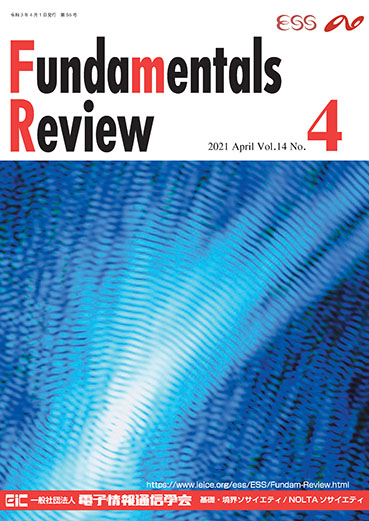Volume 14, Issue 4
Displaying 1-22 of 22 articles from this issue
- |<
- <
- 1
- >
- >|
Cover
-
2021Volume 14Issue 4 Pages 0
Published: April 01, 2021
Released on J-STAGE: April 01, 2021
Download PDF (368K)
Table of Contents
-
2021Volume 14Issue 4 Pages 266
Published: April 01, 2021
Released on J-STAGE: April 01, 2021
Download PDF (201K)
Preface
-
2021Volume 14Issue 4 Pages 267-268
Published: April 01, 2021
Released on J-STAGE: April 01, 2021
Download PDF (261K)
Review Papers
Proposed by MSS (Mathematical Systems Science and its applications)
-
2021Volume 14Issue 4 Pages 269-278
Published: April 01, 2021
Released on J-STAGE: April 01, 2021
Download PDF (2729K)
Proposed by EA (Engineering Acoustics)
-
2021Volume 14Issue 4 Pages 279-286
Published: April 01, 2021
Released on J-STAGE: April 01, 2021
Download PDF (1186K)
Proposed by R Reliability
-
2021Volume 14Issue 4 Pages 287-296
Published: April 01, 2021
Released on J-STAGE: April 01, 2021
Download PDF (1625K)
Proposed by TL (Thought and Language)
-
2021Volume 14Issue 4 Pages 297-307
Published: April 01, 2021
Released on J-STAGE: April 01, 2021
Download PDF (879K)
Proposed by CCS (Complex Communication Sciences)
-
2021Volume 14Issue 4 Pages 308-317
Published: April 01, 2021
Released on J-STAGE: April 01, 2021
Download PDF (3136K)
Proposed by BioX (Biometrics)
-
2021Volume 14Issue 4 Pages 318-328
Published: April 01, 2021
Released on J-STAGE: April 01, 2021
Download PDF (6346K)
Proposed by ISEC (Information Security)
-
2021Volume 14Issue 4 Pages 329-336
Published: April 01, 2021
Released on J-STAGE: April 01, 2021
Download PDF (995K)
Proposed by VLD (VLSI Design Technologies)
-
2021Volume 14Issue 4 Pages 337-346
Published: April 01, 2021
Released on J-STAGE: April 01, 2021
Download PDF (1513K)
Miscellaneous Articles
Let's go to IEICE Workshops!
-
2021Volume 14Issue 4 Pages 347-348
Published: April 01, 2021
Released on J-STAGE: April 01, 2021
Download PDF (299K)
International Conference Report
-
2021Volume 14Issue 4 Pages 349-350
Published: April 01, 2021
Released on J-STAGE: April 01, 2021
Download PDF (406K) -
2021Volume 14Issue 4 Pages 351-352
Published: April 01, 2021
Released on J-STAGE: April 01, 2021
Download PDF (499K)
Tokyo Institute of Technology Ookayama Campus Report
-
2021Volume 14Issue 4 Pages 353-354
Published: April 01, 2021
Released on J-STAGE: April 01, 2021
Download PDF (883K)
Winners' Voice
-
2021Volume 14Issue 4 Pages 355-357
Published: April 01, 2021
Released on J-STAGE: April 01, 2021
Download PDF (505K) -
2021Volume 14Issue 4 Pages 358
Published: April 01, 2021
Released on J-STAGE: April 01, 2021
Download PDF (43K) -
2021Volume 14Issue 4 Pages 359-360
Published: April 01, 2021
Released on J-STAGE: April 01, 2021
Download PDF (285K)
Call for Papers
-
2021Volume 14Issue 4 Pages 361
Published: April 01, 2021
Released on J-STAGE: April 01, 2021
Download PDF (1013K) -
2021Volume 14Issue 4 Pages 362
Published: April 01, 2021
Released on J-STAGE: April 01, 2021
Download PDF (614K) -
2021Volume 14Issue 4 Pages 363
Published: April 01, 2021
Released on J-STAGE: April 01, 2021
Download PDF (993K)
Committees & Editors Notes
-
2021Volume 14Issue 4 Pages 364-366
Published: April 01, 2021
Released on J-STAGE: April 01, 2021
Download PDF (330K)
- |<
- <
- 1
- >
- >|
